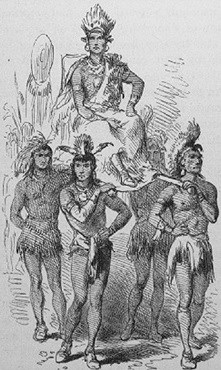
Savannah Images Project In today's Southeastern United States, the term Coosa is most likely associated with the Coosa River, which meanders through northeast Alabama and northwest Georgia, but when the Spanish entradas of Hernando de Soto, Tristan de Luna, and Juan Pardo first set foot in the region between 1539 and 1568, Coosa had a very different connotation. First, Coosa referred to the town of The structural makeup of a Mississippian chiefdom and its governing body in the1540s was far more advanced than the Spanish gave credit. A chiefdom normally had anywhere from 100-1500 permanent residents living within its borders. The typical chiefdom had a town that served as the capitol, while several smaller, outlying towns paid tribute to a central cacique. At least one archaeological model illustrates that less complex chiefdoms consisted of a cluster of towns with a large capitol town normally containing several mounds.The cacique used his food surplus for supporting part-time artisans that made special goods for those who could afford them and for supporting the chiefdom's warriors. Towns in Mississippian culture serving as boundaries to the chiefdom were often fortified with palisade walls, defensive towers, and defensive ditches.The capitol town contained the cacique's house, a temple or temples, and other important public buildings.Natives built most of these public buildings atop pyramid shaped, flat-topped, earthen mounds that took several years to construct.Primarily, these mounds elevated the elite class above the commoners and asserted the cacique's power over his surrounding chiefdom.Normally, a plaza, neighbored by or enclosed by the capitol's public buildings and residents' homes, supported recreational activities. According to the Soto reports, the elite inhabitants lived near the caciques dwelling on the edge of the plaza, while the lower classes dwelt near the outskirts of town. Bibliography Knight, Smith, Marvin T. Coosa. Steponaitis, Vincas. "Location Theory and Complex Chiefdoms: A Mississippian Example." In Mississippian Settlement Patterns, ed. Bruce D. Smith, 417-453. New York: Academic Press, 1978. Widmer, Randolph J. "Structure of Southeastern Chiefdoms." In Forgotten Centuries: Indians and Europeans in the American South, 1521-1704. Athens: University of Georgia Press, 1994. |
Last updated: April 14, 2015
